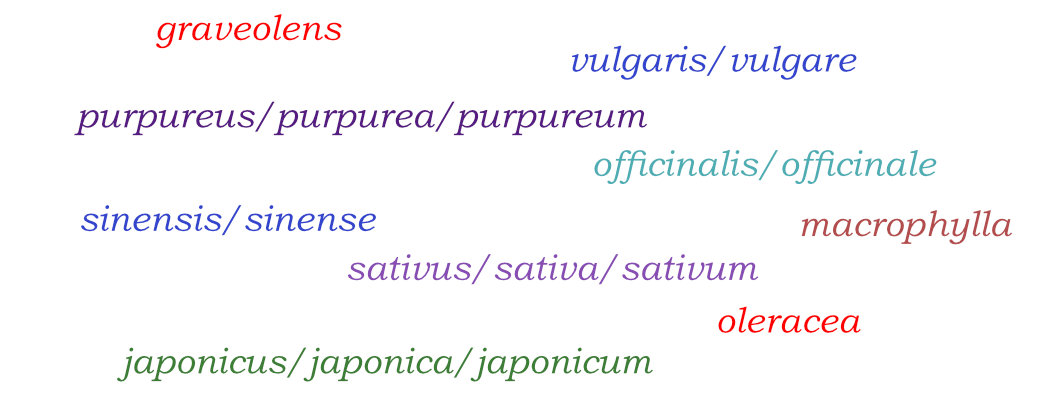
Title image above is copyright © Optimate Group Pty Ltd
First published 20th May 2021
This earlier post covered the rules that apply when naming a plant scientifically.
This post follows on from that, by listing the words which are quite common to these names — and this can be both fun and really handy to know, as these words are quite descriptive once you know their meanings!
(This list is by no means definitive and I plan to add to it over time.)
Let’s begin!
Words Common in the ‘Species’ Part of the Binomial Name
The ‘species’ part of the binomial name is the second word, always italicised and always beginning with a lowercase letter.
Many of these words have masculine, feminine, and neuter forms.
graveolens
Latin for ‘strong-smelling’
Examples:
Anethum graveolens (dill)
Ruta graveolens (rue)
japonicus (masculine form)/japonica (feminine form)/japonicum (neuter form)
Latin for ‘of/from Japan’
Examples:
Citrus japonica (cumquat)
Camellia japonica (Japanese camellia)
macrophylla
New Latin for ‘having very large leaves’
Examples:
Ficus macrophylla (Moreton Bay fig)
Hydrangea macrophylla (hydrangea)
officinalis (masculine and feminine form)/officinale (neuter form)
Mediaeval Latin used in this context to denote that the named species has medicinal or culinary properties. (The literal meaning is ‘of or belonging to an officīna’, the medicinal storeroom of a monastery.)
Examples:
Rosmarinus officinalis (rosemary)
Calendula officinalis (pot marigold)
Zingiber officinale (ginger)
oleracea
Latin for ‘vegetable/herbal’
Examples:
Brassica oleracea (numerous forms including cabbage, broccoli, cauliflower)
Spinacia oleracea (spinach)
purpureus (masculine form)/purpurea (feminine form)/purpureum (neuter form)
Latin for ‘purple’
Examples:
Calostemma purpureum (garland lily)
Echinacea purpurea (purple coneflower)
sativus (masculine form)/sativa (feminine form)/sativum (neuter form)
Latin for ‘cultivated’, typically associated with crop plants grown for nutrition
Examples:
Cucumis sativus (cucumber)
Oryza sativa (rice)
Allium sativum (garlic)
sinensis (masculine and feminine form)/sinense (neuter form)
Latin for ‘of/from China’
Examples:
Citrus sinensis (navel orange)
Camellia sinensis (tea-leaf plant)
violaceus (masculine form)/violacea (feminine form)/violaceum (neuter form)
Latin for ‘violet colour’
Examples:
Tulbaghia violacea (society garlic)
Xanthosoma violaceum (‘Black Elephant’s Ear’)
vulgaris (masculine and feminine form)/vulgare (neuter form)
Latin for ‘common’
Examples:
Berberis vulgaris (barberry)
Foeniculum vulgare (fennel)


















Leave a Comment